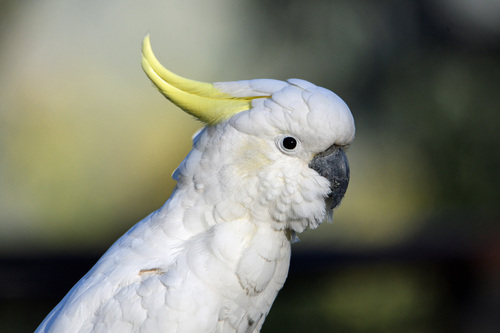
Sulphur-crested Cockatoo
The Sulphur-crested Cockatoo (*Cacatua galerita*) is a large, white parrot native to Australia, New Guinea, and some Indonesian islands. Known for its striking yellow crest, loud calls, and intelligence, it plays a significant ecological role as a seed disperser. These birds are highly social and often seen in large flocks, especially near food sources. In some parts of Australia, they are considered agricultural pests, while in others, they are beloved icons of the bush. Culturally, they are popular pets, though their demanding care requirements make them unsuitable for many owners.
44-55 cm
Length
80-100 cm
Wingspan
Least Concern
Conservation Status
Distribution
Eastern and northern Australia, Tasmania, New Guinea, and some Indonesian islands (e.g., Aru Islands). Introduced populations exist in New Zealand and Palau. They can range from sea level to around 1,500 meters in altitude.
Lifespan
Up to 70 years in captivity; 20-40 years in the wild is more typical.
Sulphur-crested Cockatoo's Habitat
Habitat Types
Woodlands, Forests (including rainforest edges), Savannas, Agricultural areas, Urban parks and gardens
Climate Zones
Tropical, Subtropical, Temperate
Adaptations
Strong beaks for cracking hard nuts and seeds. Zygodactyl feet (two toes forward, two backward) provide excellent grip for climbing and manipulating food.
Variations
Four recognized subspecies: *C. g. galerita* (eastern Australia), *C. g. fitzroyi* (northern Australia), *C. g. triton* (New Guinea and surrounding islands), and *C. g. eleonora* (Aru Islands). These differ slightly in size and crest shape.
Appearance
Breeding Plumage
No significant difference.
Seasonal Feather Changes
None.
Sex Based Plumage Differences
Subtle; males often have darker irises (dark brown to black) compared to females (reddish-brown), but this is not always a reliable indicator.
Notable Features
Prominent, forward-curving yellow crest., Pale yellow wash on the underside of the wings and tail., Strong, black beak., Greyish-black legs and feet.
Diet and Feeding
Primary Foods
Seeds, Nuts, Fruits, Berries, Roots, Insects and their larvae
Foraging Behavior
Forages on the ground, in trees, and sometimes in crops. Uses its strong beak to crack open seeds and nuts. Often feeds in large flocks, with some birds acting as sentinels.
Specializations
Powerful beak adapted for cracking hard seeds and nuts. Dexterous feet for holding and manipulating food items.
Seasonal Diet Variations
Diet varies depending on food availability. May consume more insects during the breeding season to provide protein for chicks.
Behavior
Social Structure
Highly social; forms large flocks, especially outside the breeding season. These flocks can number in the hundreds.
Communication
Loud, raucous calls (screeches and squawks)., Crest position signals mood (raised when excited or alarmed)., Body postures and head movements.
Migration
Generally non-migratory, but may undertake local movements in response to food availability.
Territorial or Group Behaviors
Breeding pairs defend a nesting territory. Flocks have a social hierarchy, with dominant birds having priority access to food and mates.
Conservation
Threats
Habitat loss (due to deforestation and land clearing), Illegal trapping for the pet trade (in some areas), Persecution as agricultural pests (in some regions), Competition with introduced species (e.g., for nesting hollows)
Protection Programs
Protected under Australian law (e.g., Environment Protection and Biodiversity Conservation Act 1999)., CITES Appendix II (regulates international trade).
Local National Laws
Protected in all Australian states and territories. Permits are required for keeping or trading them.
Population Trend
Stable
Population Estimates
Global population is estimated to be >500,000 individuals.
Interesting Facts
They are known for their intelligence and problem-solving abilities.
They have been observed using tools (e.g., sticks) to extract food from crevices.
They can mimic human speech and other sounds.
This is a common trait among parrots, and Sulphur-crested Cockatoos are particularly adept at it.
They can live for a very long time.
Captive birds can live for over 70 years, making them a long-term commitment as pets.
They are one of the largest cockatoo species.
Their size and striking appearance make them easily recognizable.
Sulphur-crested Cockatoos have a powdery down.
This powder helps waterproof their feathers and keep them clean.
Faqs about Sulphur-crested Cockatoo
Are Sulphur-crested Cockatoos good pets?
They can be affectionate and intelligent pets, but they are very demanding. They require a lot of attention, large enclosures, and specialized care. They are also very loud and can be destructive if their needs are not met.
What do Sulphur-crested Cockatoos eat?
They eat a variety of seeds, nuts, fruits, berries, roots, and insects. In captivity, they require a specialized diet formulated for cockatoos.
Are Sulphur-crested Cockatoos noisy?
Yes, they are very loud birds and can make a variety of raucous calls.
Do Sulphur-crested Cockatoos mate for life?
Generally, yes. They form strong pair bonds and often remain with the same partner for many years.
Why do Sulphur-crested Cockatoos raise their crests?
They raise their crests when they are excited, alarmed, or displaying to other cockatoos. It's a form of communication.
Copyright @ Nature Style Limited. All Rights Reserved.
 English
English